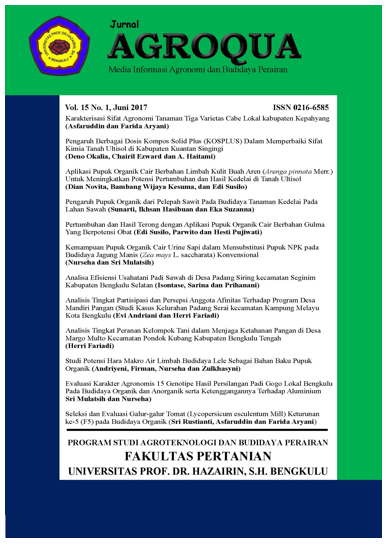PENGUJIAN HERBISIDA FORMULASI UNIHAZ PADA BERBAGAI JENIS GULMA
DOI:
https://doi.org/10.32663/ja.v18i2.1427Keywords:
Clidemia hirta, environmentally friendly, Melastoma malabathricum, organic herbicide, Scleria sumatrensisAbstract
This experiment aims to determine the effect of the herbicide Unihaz formulation on 30 types of weeds that are dominant in agricultural land. The target weeds consist of 10 types of grass weeds, 10 types of nut weeds and 10 types of broadleaf weeds. The tested weeds were sprayed with a herbicide of Unihaz formulation at a dose of 50 l / ha. The results of the study concluded that the herbicide of formulation Unihaz was effective in controlling the 10 weeds of the types of grass, namely Paspalum cunjugatum, Ischaemum timorence, Chrisopogon aciculatus, Brachiaria pospoloides, Echinochloa crus-galli, Imperata cylindrica, Axonopus compressus, Ischaemum globosa, and Cyrtococum oxyphyum. This herbicide was also effective in controlling the 10 weeds of the nut species, namely Cyperus brevifolius, Cyperus trachysanfos, Fimbristylis globulosa, Scleria sumatrensis, Cyperus aromaticus, Cyperus diformis, Scirpus mucronatus, Rhynchospora crystilis, Cyperus digitarius, and Fimbristylis malaceae. The herbicide of formulation Unihaz effectively controls eight types of broadleaf weeds, namely Urena lobota, Helyotis verticilata, Crassocephalum crapidiodes, Emilia sonchifolia, Asystasia intrusa, Mikania cordata, Hyptis suaveolens, and Borreria alata, and was not very effective in controlling the weeds Clidemia hirta, and Melastoma malabatricum.
Downloads
Published
Issue
Section
License
Authors who publish with this journal agree to the following terms:
- Authors grant the journal right of first publication with the work simultaneously licensed under a Creative Commons Attribution 4.0 Internasional (CC BY 4.0) Licence that allows others to use and share the work with an acknowledgment of the work's authorship and initial publication in this journal.
- The author(s) still hold the copyright of his/her/their work and retain publishing rights without restrictions such as (but not limited to) patent right, lecture, book and reproduce the article for own purposes.
















